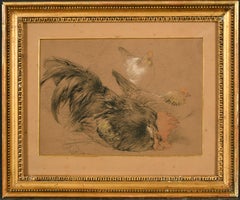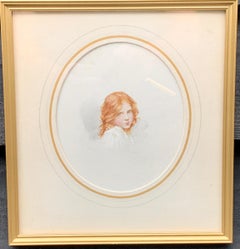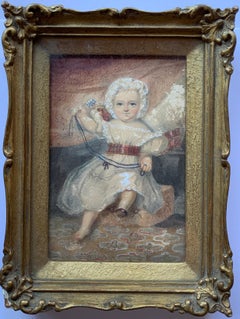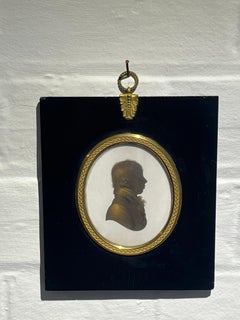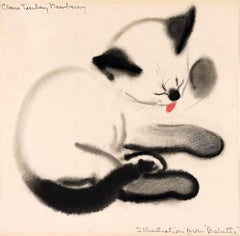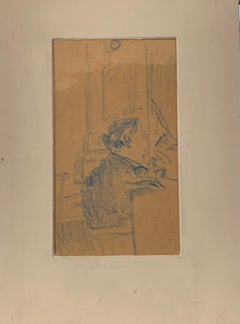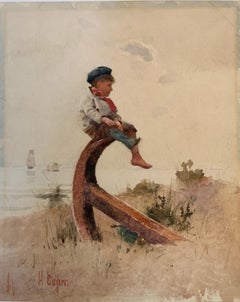Woodbury - Portrait Drawings and Watercolors
to
3
4
Overall Width
to
Overall Height
to
2
2
2
3
1
4
3
2
2
1
1
1
1
1
1
3
3
3
1
1
1
4
2,178
1,481
Item Ships From: Woodbury
Early 20th century English portrait of a young girl, Deborah Blencowe
By Louise Burrell
Located in Woodbury, CT
Louise H. "Louie" Burrell (née Luker 1873 – 1971) was an English-born artist who also lived in Canada and the United States.
The daughter of William and Ada Luker, both artists, Bur...
Category
1920s Victorian Woodbury - Portrait Drawings and Watercolors
Materials
Paper, Watercolor
$1,160 Sale Price
20% Off
Pair of 19th century English chalk drawing on paper of Cockerel
By William Huggins
Located in Woodbury, CT
William Huggins was born in Liverpool, England on the 13th of May, 1820. His parents were Samuel and Elisabeth Huggins. He took his first drawing lessons from the Liverpool Mechanics...
Category
1870s Victorian Woodbury - Portrait Drawings and Watercolors
Materials
Paper, Pastel
$3,160 Sale Price
20% Off
Early 20th century English portrait of a red haired young girl
By Louise Burrell
Located in Woodbury, CT
Louise H. "Louie" Burrell (née Luker 1873 – 1971) was an English-born artist who also lived in Canada and the United States.
The daughter of William and Ada Luker, both artists, Bur...
Category
1920s Victorian Woodbury - Portrait Drawings and Watercolors
Materials
Paper, Watercolor
Victorian Portrait of little baby Girl or Child playing with her toys
Located in Woodbury, CT
Wonderful Early Victorian English watercolor of a little girl. The piece is full of quality and precise brushwork giving the painting a great feeling. I think the frame is later poss...
Category
1830s Victorian Woodbury - Portrait Drawings and Watercolors
Materials
Watercolor
$1,160 Sale Price
20% Off
Related Items
John Field early 19th Century Georgian English silhouette portrait
Located in Harkstead, GB
A very finely detailed silhouette in very good condition by one of the truly great silhouette artists of the Georgian period.
John Field (1758-1821)
Portrait of a young gentleman
Watercolour with bronze touches on plaster
3 x 2½ inches, oval, without the frame
6 x 5 inches with the frame
John Field was one of the most famous of silhouette artists. He began his career as an assistant to John Miers...
Category
Early 19th Century Victorian Woodbury - Portrait Drawings and Watercolors
Materials
Bronze
$404 Sale Price
20% Off
H 3 in W 2.5 in D 0.5 in
Babette the Cat, Female Illustrator
Located in Miami, FL
A stylized cat named Babette is depicted licking her paw. It is rendered in black and white, which bears the influence of Asian art in its simplicity of line, use of wash, and bleedi...
Category
1930s American Impressionist Woodbury - Portrait Drawings and Watercolors
Materials
Paper, Crayon, Watercolor, Pencil
French Boy in Bloomers
By Raymond Debieve
Located in London, GB
'French Boy in Bloomers', gouache on art paper (circa 1960s-70s), by Raymond Debiève. A young boy emerges from a beach cabana wearing a bloomer bathing costume that was still in use ...
Category
1960s Modern Woodbury - Portrait Drawings and Watercolors
Materials
Paper, Gouache
The Family
By Raymond Debieve
Located in London, GB
'The Family', gouache on fine art paper (1984), by Raymond Dèbieve. In a clear nod to Picasso's influence both stylistically and in terms of subject matter ...
Category
1980s Modern Woodbury - Portrait Drawings and Watercolors
Materials
Paper, Gouache
Peter Skeolan mid 19th Century English silhouette portrait of a lady
Located in Harkstead, GB
A finely detailed silhouette of a Victorian lady
Attributed to Peter Skeolan (1815-1871)
Portrait of a lady, profile to the right
Watercolour with gold highlighting on paper/card
3¼...
Category
Early 19th Century English School Woodbury - Portrait Drawings and Watercolors
Materials
Paper, Watercolor
$252 Sale Price
30% Off
H 3.25 in W 2.75 in D 0.5 in
1950s "Purple Head" Mid Century Oil and Pastel Portrait Original Drawing
By Donald Stacy
Located in Arp, TX
Donald Stacy
"Purple Head"
c.1950s
Gouache and oil pastel on paper
13.75" x 17" unframed
Unsigned
Came from artist's estate
Donald Stacy (1925-2008) New Jersey
Studied: Newark School of Fine Art
The Art Students League
Pratt Graphic Arts Center
University of Paris 1953-54
University of Aix-en-Provence 1954-55
Faculty: Art Department of the New School
Museum of Modern Art
School of Visual Arts
Stacy Studio Workshop
Exhibitions: Grand Central Moderns
George Wittenborn
The New School
Print Exhibitions, Chicago
University of Oklahoma
Honolulu Museum
Monclair Museum
Wisconsin State College
Louisiana Art Commission
Philadelphia Print...
Category
Mid-20th Century American Modern Woodbury - Portrait Drawings and Watercolors
Materials
Paper, Oil Pastel, Gouache
$570 Sale Price
40% Off
H 17 in W 13.75 in
St. John the Baptist in the wilderness , Ecce Agnus Dei (Behold the Lamb of God)
By Giovanni Francesco Barbieri (Il Guercino)
Located in Middletown, NY
Pen and sepia ink and wash on vellum, 8 7/8 x 10 1/2 inches (225 x 267 mm). In very good condition with some modern notations in pencil on the verso, minor cockling, and a 1-inch hor...
Category
Mid-17th Century Old Masters Woodbury - Portrait Drawings and Watercolors
Materials
Ink, Watercolor, Vellum, Pencil
$650
H 8.88 in W 10.5 in
Original-Meeting Van Gogh-Study Master Series-British Awarded Artist-Ink Drawing
Located in London, GB
-In light of new tariffs, we’ve applied a 20% discount off the market price of this piece to support our collectors in facing potential added costs. At the gallery, we work closely w...
Category
2010s Contemporary Woodbury - Portrait Drawings and Watercolors
Materials
Ink, Archival Paper, Charcoal, Gouache, Acrylic
$521
H 8.27 in W 11.7 in D 0.08 in
Hinton Gibbs, Early 19th Century English Victorian silhouette portrait
Located in Harkstead, GB
A finely detailed silhouette of a Victorian gentleman.
Hinton Gibbs (1783-1839)
Portrait of a gentleman, bust length, turned to the left, wearing coat and cravat
watercolour, revers...
Category
Early 19th Century English School Woodbury - Portrait Drawings and Watercolors
Materials
Watercolor, Glass
$239 Sale Price
30% Off
H 2.75 in W 2.25 in D 0.5 in
Mother and Child II
By Raymond Debieve
Located in London, GB
'Mother and Child II', watercolour on fine art paper (1970), by Raymond Debiève. In a clear nod to Picasso's influence both stylistically and in terms of subject matter (Picasso pain...
Category
1970s Modern Woodbury - Portrait Drawings and Watercolors
Materials
Paper, Watercolor
Nur Jahan seated with a painted spice jar. Rajasthani School, 19th cent.
Located in Middletown, NY
Ink and gouache with gold heightening on fibrous, brown laid paper with a Jaipur Court Fee tax stamp in purple ink, 13 3/8 x 8 3/4 inches (340 x 222 mm). Toning, handling creases and...
Category
19th Century Rajput Woodbury - Portrait Drawings and Watercolors
Materials
Gold
$1,200
H 13.38 in W 8.75 in
French Art Deco Woman Singing Gouache Painting
Located in Atlanta, GA
A lovely gouache on cardboard painting featuring an Art Deco singer with a typical stylish outfit. Utilizing the contrast of black and white components against primary colors like y...
Category
1930s Art Deco Woodbury - Portrait Drawings and Watercolors
Materials
Gouache, Board, Cardboard
Previously Available Items
The Conductor , Modern British blue crayon drawing portrait the theatre
By Walter Richard Sickert
Located in Woodbury, CT
Outstanding small oil or wax crayon drawing of a Conductor, inscribed on the original backing from the original time the piece was framed 'The Conductor" either the Old Middlesex or Bedford Theatre, W.R.Sickert.
Both theaters were known places where Sickert painted and sketched.
Unlike the majority of the Camden Town Group, Walter Richard Sickert was recognized during his own life as an important artist, and in the years since his death has increasingly gained a reputation as one of the most influential figures in twentieth-century British art. He was universally acknowledged throughout his life as a colorful, charming, and fascinating character, a catalyst for progress and modernity, yet someone who remained independent of groups, cliques, and categories. As a younger man, he was widely reported to be an entertaining and skilled raconteur, popular within cultural and social circles and friendly with numerous famous personalities of the era. In his old age, he cultivated his many eccentric habits and courted a level of celebrity, frequently appearing in the newspapers for having changed his appearance, his name, or for his latest controversial painting stunt. His art, like his personality, is multifaceted, complex, and compelling.
Sickert was a cosmopolitan figure. The eldest of six children, he was born in Munich on 31 May 1860 to a Danish father (with German nationality) and an Anglo-Irish mother. His early years were spent in Germany, but in 1868 the family moved to England. London remained his principal home for the rest of his life, although he also lived for periods in France and Italy. He spoke fluent English, German and French, and had a good command of Italian. His father, Oswald Adalbert Sickert, was a painter and woodcut illustrator for a comic paper, the Fliegende Blätter, and although his young son received no early formal training, art and culture formed an integral part of his upbringing. His schooling was undertaken in a variety of establishments including the King’s College School, London.
Aged eighteen, Sickert was discouraged from pursuing an artistic career by his father and turned instead to his other great passion, the theatre. Under the alias ‘Mr. Nemo’, he took up acting and appeared in minor roles in several touring productions. Art, however, continued to occupy him and in 1881 he signed up for a year’s ‘General Course’ at the Slade School of Fine Art. The final step towards his chosen path came in 1882 when Sickert abandoned the stage in order to become an apprentice in the studio of his great hero, James Abbot McNeill Whistler (1834–1903). The American artist advised him to leave the Slade, remarking with characteristic acerbic wit, ‘You’ve lost your money, no need to lose your time as well’.1 Sickert’s role under Whistler was largely that of a studio assistant and dogsbody and he learned a good deal of technical and practical knowledge about painting and printmaking. By observation, he also imbibed lessons about Whistler’s painting techniques and began to produce work himself in the style of the master. In 1883 he was entrusted by Whistler to courier his famous Portrait of the Artist’s Mother to the Paris Salon,2 a trip which led to an introduction with the other great influence in his life, Edgar Degas (1834–1917). Over the next five years, he continued to learn from the example of these two great figures of modern painting and began to establish a reputation for himself as a painter of low-toned landscapes. In 1885 he married his first wife Ellen Cobden and the couple spent the summer touring Europe, culminating in a prolonged stay in Dieppe, the town that was to become a beloved fixed constant in his life. He renewed his acquaintance with Degas and made friends with many other young French writers and artists including Jacques-Emile Blanche (1861–1942).
Following Degas’s example, Sickert began to move away from Whistler’s instruction to paint from nature with a wet-in-wet technique. Instead, he established the regime he was to follow for the rest of his life of painting in the studio from drawings made on the spot. By 1887 he had fixed upon the theme which would occupy him intermittently for most of his career, the world of the British music hall, exhibiting his first painting of this subject, Le Mammoth Comique, at the Society of British Artists. A natural platform for his work at this time was the recently formed New English Art Club, which Sickert joined that year. His arrival crystallized a split within the group between the more conservative artists and those who looked to the example of French impressionism. The latter appeared as a breakaway group, the ‘London Impressionists’, in an exhibition at the Goupil Gallery in December 1889, and included, as well as Sickert, Philip Wilson Steer, Frederick Brown, Theodore Roussel, and Sickert’s brother, Bernhard.
Sickert continued to focus on the music hall as a source of inspiration, but also began to concentrate on portraits, domestic scenes from everyday life, and landscapes of Dieppe and Venice, which he visited for the first time in 1895. Following his separation and divorce from Ellen (on the grounds of his adultery) and growing disillusionment with the New English Art Club, Sickert moved to Dieppe where he remained (with occasional sojourns in Venice) until 1906. He continued to exhibit in England but did not return to live there until a chance meeting in Dieppe with the young artist Spencer Gore tempted him back to join the new generation of progressive artists in Britain. Back in London, Sickert established himself in rooms in Camden Town and began to hold Saturday afternoon ‘At Homes’ in his studio in Fitzroy Street. His regular core of visitors became the more formalized ‘Fitzroy Street Group’, an independent, modern exhibiting society which, in 1910, evolved into the Camden Town Group. Sickert exhibited at all three of the group’s exhibitions, although his contributions were markedly different from both the subject matter and visual appearance of the other members. The paintings which drew the most interest from the critics were those which formed the ‘Camden Town Murder’ series, a number of low-toned scenes depicting a naked woman on an iron bedstead, observed by a fully-clothed man. The Camden Town Group later reconfigured into yet another permutation, the London Group, from which Sickert resigned in 1914. That same year he rejoined the NEAC where he exhibited his most famous painting, Ennui (Tate N03846).
During the First World War, Sickert was unable to take his usual summer vacation in Dieppe and began for the first time to form associations with other places, first Chagford in Devon, then Brighton, and later Bath. The war years also saw a concentrated period of etching in a studio in Red Lion Square, London. After the war, Sickert promptly returned to France and settled in Envermeu with his second wife, Christine (whom he had married in 1911). In 1920 Christine died after a long illness and by 1922 Sickert once again moved back to London, this time eschewing Camden Town for nearby Islington. In 1926 he married his third wife: friend and fellow artist Thérèse Lessore
In the later years of his life, Sickert reinvented himself physically, professionally, and artistically. In 1927 he dropped his first name, Walter, and chose instead to be known merely as Richard Sickert. His paintings still featured a familiar range of subjects including domestic interiors, portraits, townscapes, and theatrical subjects but increasingly relied on photographs, instead of drawings, as the basis for his compositions. His work gained a new level of publicity attracting both controversy and respect. Despite some considerable success and the attainment of a level of established respectability (during the 1930s he was elected to the Royal Academy and received honorary degrees from the universities of Manchester and Reading), his poor financial management brought him into difficulties. In 1934, partly as a cost-cutting exercise, he moved to St Peter’s-in-Thanet, near Broadstairs in Kent. In 1938 he moved once again to his final home in Bathampton, Somerset, wherewith the assistance of Thérèse and his long-term supporter Sylvia Gosse he continued painting until just before his death on 22 January 1942.
Sickert’s contribution to British cultural life was not restricted to his artistic output alone. He also exerted considerable influence as a writer and teacher and was a generally proactive, political force in artistic circles. He was a member of numerous societies and groups and played a vital role in the dissemination of new ideas and concepts from France to England. He taught intermittently throughout his life, both in established art institutions such as the Slade, the Westminster School of Art, and the Royal Academy Schools and in his own private schools which he opened and closed with optimistic frequency. He was widely applauded as a gifted and inspirational tutor, teaching, among many, David Bomberg, Winston Churchill, and Lord Methuen. His career as a writer lasted for nearly fifty years, during which time he regularly wrote for a number of publications including the Burlington Magazine, New Age, Art News, and Speaker. In addition, like his former mentor Whistler, he was an inveterate letter writer to the press and bombarded the newspapers with commentary and opinions. His importance as an art critic has been somewhat overlooked, overshadowed by the pre-eminence of contemporaries such as Clive Bell and Roger Fry. Unlike his Bloomsbury colleagues, Sickert did not highly rate the work of the post-impressionists Henri Matisse and Pablo Picasso, and the progressive nature of his writings was therefore underestimated. The publication of his collected writings in 2000, edited by Anna Gruetzner Robins, fully revealed for the first time his extensive contribution to shaping British attitudes to art in his own lifetime.
The first retrospective of Sickert’s work, organized during his lifetime by Lillian Browse, was held in 1941 at the National Gallery. In the same year, the first biography of the artist appeared, written by a friend and pupil, Robert Emmons. After his death, Sickert remained a notable but underestimated figure. His work was well represented in the nation’s public galleries, but he was perceived as problematically independent of the major identified movements in British art. In the latter half of the twentieth century, however, his work was reassessed and his importance revalued. Artists such as Frank Auerbach and the Euston Road School acknowledged a direct link to Sickert’s figurative and domestic interiors. The scholarly work during the 1960s and 1970s of Lillian Browse and Wendy Baron established and formed an invaluable basis for all later Sickert studies. In 1975 Richard Morphet compared Sickert’s use of photo-based source material to the later developments in pop art, and an exhibition at the Hayward Gallery in 1981–2 established the contribution to British modernism of his previously ignored late paintings. In 1992 Wendy Baron and Richard Shone curated a major show at the Royal Academy which provided the first major overview of his entire oeuvre.9 Anna Gruetzner Robins’s 1996 publication, Walter Sickert: Drawings, enhanced his growing reputation with a survey of his work as a draughtsman,10 while in 2000 Ruth Bromberg produced a catalog raisonné of his achievements as a printmaker.11 The nearest publication to a catalog raisonné of paintings and drawings is Wendy Baron’s comprehensive Sickert: Paintings and Drawings published in 2006.12
The twenty-first century has seen a sustained period of Sickert research and exhibitions, crystallizing his reputation as one of the most significant British artists of the early modern period. In addition, his celebrity was assured by the crime fiction writer, Patricia Cornwell, who published a book in 2002 claiming that Sickert was Jack the Ripper. Her assertions caused a schism among Sickert scholars but were widely agreed to be improbable and unsubstantiated. The arguments she propounded in Portrait of a Killer: Jack the Ripper – Case Closed were systematically countered by Matthew Sturgis in the last chapter of his extensive biography, Walter Sickert: A Life, published in 2005.13
This drawing was exhibited at the BADA Antique show circa 2015, the Palm Beach Antique...
Category
Early 1900s Impressionist Woodbury - Portrait Drawings and Watercolors
Materials
Oil Crayon, Wax Crayon
British Victorian sailor boy seated by the sea on an anchor
By Hector Caffieri
Located in Woodbury, CT
Hector Caffieri was born in Cheltenham, Gloucestershire, the son of French parents who had settled temporarily in England. Following a stint in the nav...
Category
1890s Victorian Woodbury - Portrait Drawings and Watercolors
Materials
Watercolor

